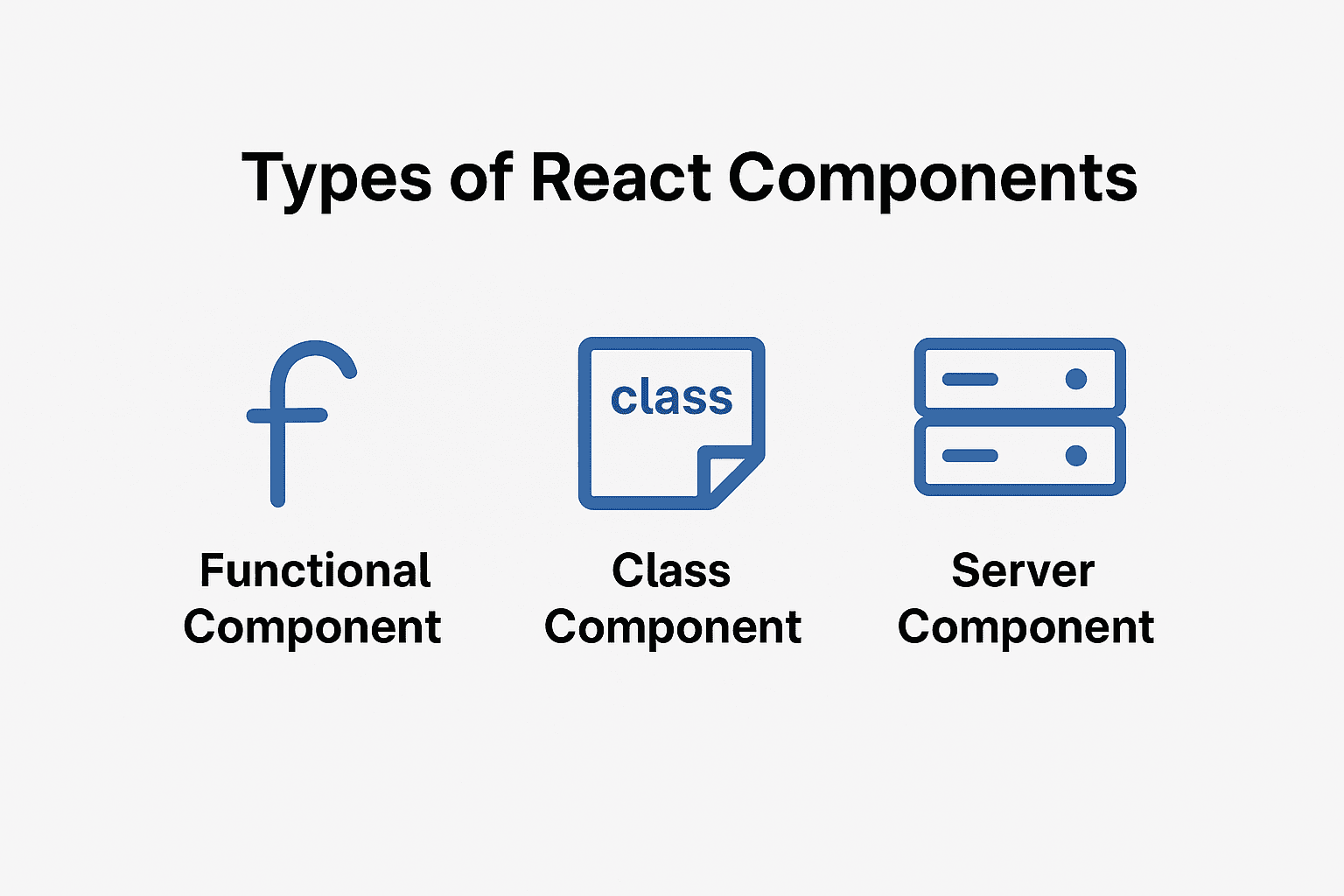React powers modern web applications, and choosing the right component type is crucial for clean, efficient development. Understanding the different types of React components—from lightweight functional components to legacy class components and innovative server components—helps developers build better apps. But what are these types, and when should you use functional, class, or server components?

What Are Functional Components?
Functional components are plain JavaScript functions that return React elements (JSX). Unlike class components, they don’t rely on ES6 classes or lifecycle methods. Instead, they use React Hooks (like useState, useEffect) to manage state and side effects.
Example Syntax:
function Greeting(props) {
return <h1>Hello, {props.name}!</h1>;
}
Key Features
- Hooks Support: Manage state and lifecycle with
useState,useEffect, etc. - Simplicity: Less boilerplate code compared to classes.
- Performance: Typically lighter and easier to optimize.
- Modern Standard: Recommended by React’s official docs.
When to Use Functional Components
- For most UI components in modern React apps.
- When building stateless or stateful logic with Hooks.
- If you want cleaner, more maintainable code.
What Are Class Components?
Class components are ES6 classes that extend React.Component. They include lifecycle methods like componentDidMount, componentDidUpdate, and componentWillUnmount to handle side effects.
Example Syntax:
class Greeting extends React.Component {
render() {
return <h1>Hello, {this.props.name}!</h1>;
}
}
Legacy Usage & Scenarios
- Widely used before React 16.8 (when Hooks were introduced).
- Still necessary for certain cases, like error boundaries, which currently can only be created with class components.
Pros & Cons Compared to Functional Components
✅ Provides built-in lifecycle methods.
✅ Supports error boundaries (currently).
❌ More verbose, harder to read.
❌ Less performant and less future-proof compared to functional components.
What Are Server Components?
React Server Components (RSC) are a new type of component introduced by the React team. Unlike client components that run in the browser, server components execute on the server and send a serialized UI tree to the client.
Benefits
- Smaller Client Bundle Size: Server components don’t ship JavaScript to the browser.
- Streaming Support: Content can be streamed progressively, improving load times.
- Better Performance: Reduce client-side rendering work, great for large apps.
Use Cases and Limitations
- Best for data-heavy UI parts, like product listings or dashboards.
- Great for SEO-sensitive pages where fast rendering matters.
- Limitations:
- Still evolving and requires frameworks like Next.js 13+ (App Router).
- Some libraries may not yet fully support RSC.
Functional vs Class vs Server Components: Side-by-Side Comparison
| Feature | Functional Components | Class Components | Server Components |
|---|---|---|---|
| Syntax & Complexity | Simple JS functions, concise | Verbose ES6 classes with render() method | Defined like functions but run on the server |
| State Management & Lifecycle | Managed using Hooks (useState, useEffect) | Managed with lifecycle methods (componentDidMount, componentWillUnmount) | No client state; fetches/handles data on the server |
| Performance Implications | Lightweight, optimized, less overhead | Heavier, less efficient compared to functional | Faster initial load, reduced bundle size, better SEO |
| Use Case Examples | General UI, modern apps, reusable components | Error boundaries, legacy projects, migration contexts | Data-heavy UI, SEO-critical pages, large scale apps with server rendering |
Choosing the Right Type
When deciding which React component type to use, keep these guidelines in mind:
- ✅ Prefer Functional Components:
Use them for most modern UI development. They’re lightweight, readable, and fully capable with Hooks. - ⚡ Use Class Components Only When Needed:
Ideal for maintaining legacy codebases or building error boundaries (until functional alternatives are fully available). - 🌍 Adopt Server Components Judiciously:
Best suited for Next.js 13+ apps, SEO-sensitive pages, and data-intensive sections. Keep in mind that RSCs are still evolving and may have ecosystem limitations.
Our AI-powered js online compiler lets you write, run, and test your code instantly. With AI’s help, it simplifies coding by catching errors, suggesting improvements, and automating repetitive tasks. Dive into the world of JavaScript with ease, and boost your coding efficiency!
Example Code Snippets
✅ Functional Component Example
function Greeting({ name }) {
return <h1>Hello, {name}!</h1>;
}
- Simple, concise, and widely used.
- State and side effects can be added with Hooks like
useStateoruseEffect.
✅ Class Component Example
class Greeting extends React.Component {
render() {
return <h1>Hello, {this.props.name}!</h1>;
}
}
- More verbose, requires a
render()method. - Lifecycle methods like
componentDidMountare used for side effects.
✅ Server Component Example (Next.js 13+)
// app/page.js (Server Component in Next.js 13+)
async function UsersList() {
const res = await fetch('https://jsonplaceholder.typicode.com/users');
const users = await res.json();
return (
<ul>
{users.map(user => (
<li key={user.id}>{user.name}</li>
))}
</ul>
);
}
export default UsersList;
- Runs on the server, not shipped as JavaScript to the client.
- Ideal for fetching data at render time.
- Requires frameworks like Next.js App Router.
Transitioning from Class to Functional Components
🔄 Tips for Migration
- Replace lifecycle methods with Hooks
componentDidMount→useEffect(() => {...}, [])componentDidUpdate→useEffect(() => {...}, [dependency])componentWillUnmount→ cleanup function inuseEffect.
- Replace
this.statewithuseState- Example:
// Class this.state = { count: 0 }; // Functional const [count, setCount] = useState(0); - Replace
this.setStatewith state updater functions- Example:
setCount(prev => prev + 1);
- Example:
Common Pitfalls & Fixes
- Forgetting dependencies in
useEffect: Always add required dependencies in the array; use ESLint rules to avoid bugs. - Overusing Hooks: Avoid putting too many effects in one component; split logic when needed.
- Confusion with
this: Nothisin functional components—use props and local variables instead.
Future of React Components
React is continuously evolving to make applications faster and more developer-friendly. The future of React components is shaped by three major directions:
- React Server Components (RSC): These reduce client bundle sizes and improve performance, making apps more scalable. They are becoming central in frameworks like Next.js.
- Suspense for Data Fetching: Suspense enables smoother user experiences by handling loading states gracefully while data is being fetched.
- Concurrent Features: Concurrent rendering allows React to prioritize important updates, improving responsiveness in large apps.
Together, these advancements indicate a shift towards more efficient, scalable, and user-focused applications.
Conclusion
Understanding the types of React components—functional, class, and server— is essential for building modern applications. Functional components are the preferred standard, class components remain relevant for specific cases, and server components represent the exciting future of React.
Experiment with each type, keep adapting to evolving best practices, and ensure your skills grow with React’s ecosystem. Want to keep learning React concepts step by step? Visit Newtum for beginner-friendly tutorials, coding guides, and practical exercises.



